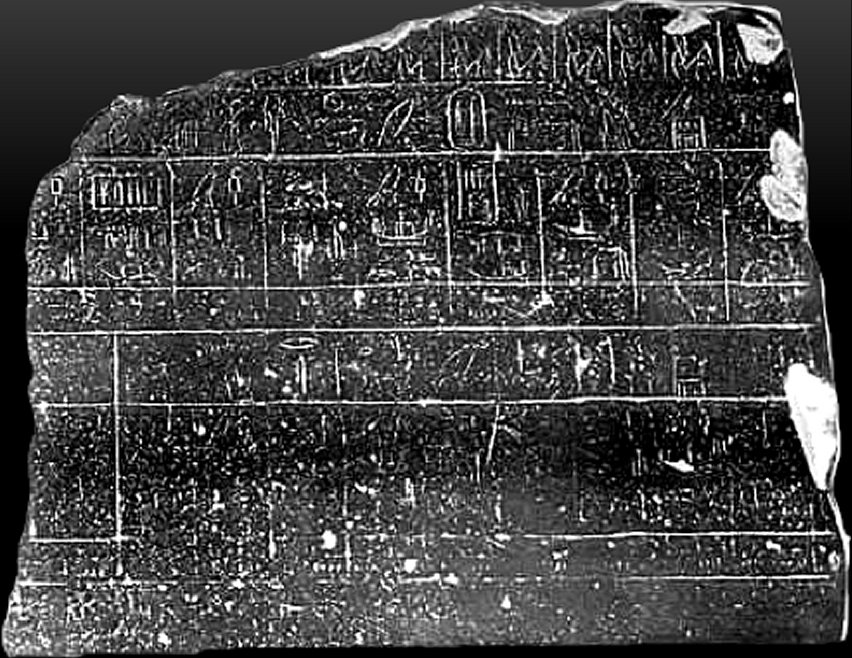Palermo Stone: One Of The Earliest History Records Of Ancient Egypt
A. Sutherland - AncientPages.com - The Palermo Stone, carved on a black basalt stele, is one of the earliest Egyptian historical texts. The original location of the artifact is unknown, but one fragment is said to have been found at an archaeological site at Memphis in 1866, while three other fragments now in Cairo were probably discovered in Middle Egypt.
It is a large fragment of a stela known as the Royal Annals of the Old Kingdom of ancient Egypt and contains records of the kings of Egypt from the first to the fifth dynasty.
The king list of Egyptian pharaohs, represents one of the basic sources of information about the chronology and cultural history of ancient Egypt during the first five dynasties (c. 2925–c. 2325 BC), although the last name preserved on the stone is that of Neferirkare, the third of the nine kings of the 5th dynasty.
On the Palermo Stone there is also chronicled that there was a civilization prior to the present one. This civilization dates back between twenty and thirty thousand years.
Named for the Sicilian city, where it has been preserved since 1877, it is one of six existing fragments from a single stela that probably originally stood in an Egyptian temple or other important building.
The Palermo Stone is an irregular shield-shaped fragment, 43.5 cm high, 25 cm wide and 6.5 cm thick (maximum dimensions).
The original to which the Palermo Stone belonged, is believed to have been about 2.2 meters long, 0.61 meters high and 6.5 cm thick.
It is generally accepted, but not proven, that the large Cairo Fragment, may have belonged to the same original.
It is inscribed on both sides with horizontal lines of hieroglyphic text, the top row listing the names of predynastic rulers.
The following rows, each headed by the name of a different king, are divided into compartments, each compartment signifying one year.
See also:
Massive Fortress Buhen In Ancient Capital Of Egyptian Nubia
Mysterious Location Of The Amazing Land Of Punt - Can This Puzzle Be Solved One Day?
Meidum: Collapsed Pyramid Of Great Builder Pharaoh Snofru
Palermo Stone consists of 6 horizontal bands or registers of hieroglyphic text running right to left. Within the compartments the hieroglyphs always list one or more memorable events of that year.

Cairo Fragment CF1 lists, among others, the start of the reign of Horus Djer. Credits: ancient-egypt.org
According to Palermo Stone, in the early 4th Dynasty, Sneferu sent a military expedition to Nubia. This expedition returned with 7,000 captives and 200,000 cattles. There is no further explanation in text, who the captives were and from which locations in Nubia.
The Palermo Stone was published and translated for the first time in 1902 by a German Egyptologist Heinrich Schäfer (1868-1957). The purpose of this ancient artifact is not clearly defined.
Was it meant to record historical events or had it another function?
Written by – A. Sutherland AncientPages.com Staff Writer
Copyright © AncientPages.com All rights reserved. This material may not be published, broadcast, rewritten or redistributed in whole or part without the express written permission of AncientPages.com
More From Ancient Pages
-
 Ancient Inscriptions Of Babylonian King Nabonidus Discovered In Saudi Arabia
Archaeology | Jul 14, 2021
Ancient Inscriptions Of Babylonian King Nabonidus Discovered In Saudi Arabia
Archaeology | Jul 14, 2021 -
 2000-Year-Old Tomb Discovered In Northwestern China
Archaeology | Dec 7, 2015
2000-Year-Old Tomb Discovered In Northwestern China
Archaeology | Dec 7, 2015 -
 5,000-Year-Old Black Death Victim Challenges Theories Of Development Of Human Civilization
Archaeology | Jul 1, 2021
5,000-Year-Old Black Death Victim Challenges Theories Of Development Of Human Civilization
Archaeology | Jul 1, 2021 -
 Sinister Mythical Dark Elves And Light Elves And Their Magical Ship ‘Skidbladnir’
Featured Stories | Oct 3, 2016
Sinister Mythical Dark Elves And Light Elves And Their Magical Ship ‘Skidbladnir’
Featured Stories | Oct 3, 2016 -
 On This Day In History: Battle Of Ayacucho Was Fought In Peru – On Dec 9, 1824
News | Dec 9, 2016
On This Day In History: Battle Of Ayacucho Was Fought In Peru – On Dec 9, 1824
News | Dec 9, 2016 -
 Radar Discovery Of Unknown Space Beyond Tutankhamun’s Burial Chamber May Lead To Queen Nefertiti’s Tomb
Archaeology | Feb 21, 2020
Radar Discovery Of Unknown Space Beyond Tutankhamun’s Burial Chamber May Lead To Queen Nefertiti’s Tomb
Archaeology | Feb 21, 2020 -
 Hacksilber Hoard Dated To 11th Century BC: Eastern Mediterranean Silver Trade Reconstructed
Archaeology | Jul 5, 2021
Hacksilber Hoard Dated To 11th Century BC: Eastern Mediterranean Silver Trade Reconstructed
Archaeology | Jul 5, 2021 -
 Sumerian God Enki – Commander Of Eridu
Featured Stories | Sep 8, 2015
Sumerian God Enki – Commander Of Eridu
Featured Stories | Sep 8, 2015 -
 Legend Of The Candle Dragon That Could Lighten The Darkest Gate Of Heaven
Chinese Mythology | Jan 15, 2016
Legend Of The Candle Dragon That Could Lighten The Darkest Gate Of Heaven
Chinese Mythology | Jan 15, 2016 -
 Evidence Of Carthaginian Presence In Northern Europe?
Featured Stories | Jun 18, 2022
Evidence Of Carthaginian Presence In Northern Europe?
Featured Stories | Jun 18, 2022 -
 3,500 Underground Man-Made Maresha/Beit Guvrin Caves And Tunnels In The Holy Land
Featured Stories | Jun 1, 2014
3,500 Underground Man-Made Maresha/Beit Guvrin Caves And Tunnels In The Holy Land
Featured Stories | Jun 1, 2014 -
 Why Was Louis XIV Called The Sun King?
Ancient History Facts | Jul 11, 2019
Why Was Louis XIV Called The Sun King?
Ancient History Facts | Jul 11, 2019 -
 Manuscripts And Art Support Evidence That Syphilis Was In Europe Long Before Explorers Could Have Brought It Home
Featured Stories | Jul 15, 2022
Manuscripts And Art Support Evidence That Syphilis Was In Europe Long Before Explorers Could Have Brought It Home
Featured Stories | Jul 15, 2022 -
 Mysterious Devil’s Footprints In Maine – An Ancient Mystery That Will Never Be Solved
Featured Stories | Jul 9, 2017
Mysterious Devil’s Footprints In Maine – An Ancient Mystery That Will Never Be Solved
Featured Stories | Jul 9, 2017 -
 Cheomseongdae “Star-Gazing Tower” Is The Oldest Observatory In East Asia
Featured Stories | Mar 31, 2021
Cheomseongdae “Star-Gazing Tower” Is The Oldest Observatory In East Asia
Featured Stories | Mar 31, 2021 -
 Wasabi Plant Can Save Ancient Bio-Deteriorated Papyrus
Scripts, Paintings & Inscriptions | Apr 4, 2024
Wasabi Plant Can Save Ancient Bio-Deteriorated Papyrus
Scripts, Paintings & Inscriptions | Apr 4, 2024 -
 Mysterious Sumerian Queen Puabi And Her Magnificent Underground Burial Complex – Many Followed Her To Afterlife
Featured Stories | Oct 20, 2016
Mysterious Sumerian Queen Puabi And Her Magnificent Underground Burial Complex – Many Followed Her To Afterlife
Featured Stories | Oct 20, 2016 -
 Controversial Stone Statues Of Niulang And Zhinyu And The Legend Of The Heavenly Queen And Milky Way
Artifacts | Sep 8, 2017
Controversial Stone Statues Of Niulang And Zhinyu And The Legend Of The Heavenly Queen And Milky Way
Artifacts | Sep 8, 2017 -
 Secrets Of Quipu – Ancient Inca Message Decoded By Student
Archaeology | Dec 27, 2017
Secrets Of Quipu – Ancient Inca Message Decoded By Student
Archaeology | Dec 27, 2017 -
 Mysterious Fontainebleau Forest – Home To A Lost Civilization
Civilizations | Jun 23, 2020
Mysterious Fontainebleau Forest – Home To A Lost Civilization
Civilizations | Jun 23, 2020

